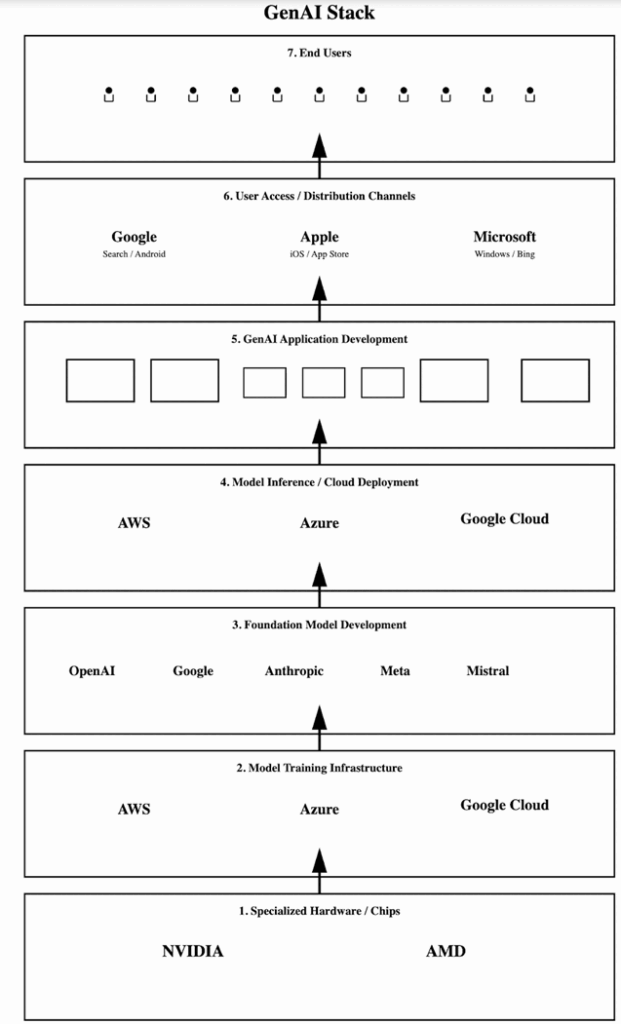Judge Amit Mehta shaped his remedies in the Google Search case on the assumption that startups developing generative artificial intelligence models can restore competition in internet search. Mihir Kshirsagar analyzes the barriers to entry these startups face—scale, distribution, defaults, data and integration advantages, and content access—to show how Big Tech is still in control of the future of the search industry.
Last month, OpenAI rolled out a feature that lets users buy products directly through the company’s artificial intelligence chatbot, ChatGPT. Ask for “the best running shoes under $100,” and ChatGPT returns product recommendations with images, prices, and reviews, followed by a “Buy” button right in the chat. No external links. No app switching. Just instant checkout, powered by what OpenAI calls the “Agentic Commerce Protocol.”
Judge Amit Mehta predicted this development. In the recently concluded Google Search antitrust case, Mehta ruled that Google unlawfully maintained its monopoly in internet search through contracts making it the exclusive default search engine for several prominent browsers, cellular service providers, and Android mobile phones. The court’s remedies focused on how the court should end these exclusive arrangements and create opportunities for fairer competition. Some of the remedies proposed by the plaintiff—the Department of Justice—included requiring Google to divest its Chrome browser or Android operating system. Mehta opted for remedies that some experts considered to be restrained, mostly focusing on data-sharing and ensuring any arrangements were not exclusive. However, Mehta allowed Google to continue paying for default placement. So, Google can still pay Apple over $20 billion annually to be a default search option.
Mehta justified the restraint of his remedies on the assumption that generative artificial intelligence (GenAI) companies will soon move into Google’s search market by challenging its search engine with its chatbots and monetizing their services by adopting Google’s business model for search advertising, where companies pay for prominent placement in responses to user queries. Mehta thought GenAI would likely upset Google’s dominance and reintroduce competition into the search market, negating the need for harsher remedies that could cripple Google’s ability to eventually compete with the emergent technology. As Mehta concluded: “The money flowing into this space, and how quickly it has arrived, is astonishing. These companies already are in a better position, both financially and technologically, to compete with Google than any traditional search company has been in decades (except perhaps Microsoft).” He added: “These new realities give the court hope that Google will not simply outbid competitors for distribution if superior products emerge.”
Mehta’s decision depends on competition coming from the development and commercialization of GenAI firms’ foundation models. However, there are barriers to the reinvigoration of competition in the search and search advertising markets from GenAI firms. The other elements of the GenAI pipeline, as seen in Figure 1—access to cloud computing, distribution, and licensed data—are important bottlenecks where only a limited set of companies have the ability to service users at scale. This article examines the foundations for Mehta’s view that the emergence of GenAI has changed the competitive landscape for online search and assesses what it would take for his view to be correct.
Figure 1. The GenAI pipeline

Testing assumptions
Mehta’s analysis views GenAI as an external competitive force emerging from outside online search that will restore competition to the online search market. In doing this, he falls into a familiar trap of assuming that GenAI burst on the scene in November 2022, when OpenAI launched ChatGPT. But GenAI didn’t develop independently of search; it developed from search. It represented search technology developed to understand language and user intent and deployed in a conversational interface. The company that monopolized search through distribution—Google—also developed the core technology powering GenAI. If GenAI is essentially information-seeking using technology developed to solve search problems, then Google and other incumbent search engines are simply facing a format shift they’re uniquely positioned to dominate.
Mehta’s remedy assumes GenAI will create meaningful competition in search. For any GenAI to restore competition, it must overcome the same barriers that prevented search competition: scale, distribution, defaults, data and data integration advantages, and content access. Let’s examine each one against the current evidence.
1. Scale
Assumption: GenAI firms have independent access to resources that allow them to use scale to compete with incumbents.
Evidence: Scale in GenAI operates at two levels—training foundation models and serving them to users—and both require resources concentrated among a handful of companies.
Training a frontier foundation model used to power AI chatbots now costs between $100 million and $1 billion and requires access to tens of thousands of graphics processing units (GPU) for months. The computational infrastructure needed exists almost exclusively within gigantic—or what the industry called hyperscaler—data centers. Nvidia, the world leader in the design and manufacture of GPUs, develops advanced AI chips upon which many of these data centers rely. However, supply and distribution of Nvidia’s chips is constrained by manufacturing capacity and strategic partnerships. Microsoft, Google, Amazon, and Meta receive priority access. OpenAI trains models through Microsoft’s Azure infrastructure. Anthropic, another AI startup, relies on Amazon Web Services. The chip shortage isn’t just about money—it’s about relationships with hyperscalers who control both GPU allocation and the data center infrastructure to deploy them.
Inference costs—serving AI responses to users—create a second scale barrier. OpenAI’s operating costs reportedly exceeded $5 billion in 2024, with most spent on special resources needed to run AI systems, known as compute, for serving ChatGPT responses. Without Microsoft’s infrastructure subsidy and the guaranteed distribution from Bing integration, OpenAI would need to either charge significantly higher prices or dramatically limit free tier access. Anthropic faces similar constraints with Amazon’s backing.
The scale dynamics create a reinforcing cycle: you need massive compute to train competitive models, millions of users to justify inference costs, and distribution to reach those users. Companies lacking hyperscaler partnerships face challenging economics. They can’t match model quality without equivalent training resources, and they can’t afford to serve responses at scale without subsidized infrastructure. Notably, OpenAI depended on Microsoft’s billion dollar investment and access to the Azure infrastructure to allow it to meet the demand for ChatGPT when it became wildly popular in late 2022. This partnership was the only reason that the company could attract and retain over 100 million subscribers.
Independent AI companies that have not formed partnerships with incumbent Big Tech companies, like Stability AI and Inflection AI, have tried and failed to find alternative paths. The pattern shows that even with substantial venture funding, AI companies need either hyperscaler partnership or vertical integration into an existing platform to compete at the scale required for mainstream consumer adoption.
Mehta’s remedy assumes GenAI competition can emerge from “financially and technologically” strong companies. But the evidence shows only companies with hyperscaler cloud operations or multi-billion-dollar search revenues can sustain the costs of training, inference, and continuous model improvement at competitive scale.
2. Ease of distribution
Assumption: For GenAI to create competition, new entrants would need to achieve meaningful distribution without multi-billion-dollar payments to set their search engines or chatbots as the default choice.
Evidence: The companies that can afford non-exclusive default payments are the same ones that dominated search: Google itself, Microsoft, possibly Meta or Amazon. During the liability trial, evidence showed that 95% of users never change their defaults. The remedy transforms exclusive arrangements into competitive auctions, but only among companies with search monopolies or hyperscale cloud operations.
Even OpenAI, despite ChatGPT’s massive user base, depends on Microsoft’s backing and integration into Bing, Edge, and Office 365 for sustainable distribution. True independents like Perplexity face considerable barriers: the company has explored acquisition options precisely because it cannot access the distribution channels necessary to reach mainstream users.
The competitive battlefield has shifted to operating systems and browser-level integration, where users actually interact with AI. For example, Google integrates its AI assistant Gemini directly into its web browser Chrome’s address bar. Apple includes ChatGPT integration in Siri, but only for specific query types and as supplementary to Apple’s own intelligence features—Apple controls the terms and limits when ChatGPT appears.
Companies like Perplexity have no path to comparable integration. They must rely on users downloading separate apps and actively choosing to break habitual workflows—the same behavioral barriers that Mehta found nearly insurmountable during the liability portion of the Google Search trial.
3. Users overcoming default bias
Assumption: Superior products would need to attract users despite defaults that the court found nearly insurmountable.
Evidence: Google witnesses testified during the remedies hearing that “the Gemini app is not diverting queries from Google Search to a significant degree today” and “users don’t yet use ChatGPT for the full range of Search needs.” The default advantage that created Google’s monopoly appears to remain operative.
The court’s findings explain why it is hard to displace default search. Search operates as a reflex—users type queries into whatever box appears in their browser or phone without conscious deliberation. An upstart like Perplexity needs to convince users to: (1) recognize they have an alternative, (2) navigate to a different app or website, (3) remember to use it consistently instead of their ingrained search habit. Each step introduces friction that most users never overcome.
The query patterns show this friction clearly. ChatGPT has over 200 million weekly users but serves predominantly as a tool for specific tasks—writing assistance, coding help, creative projects—rather than replacing the dozens of daily micro-queries users send to Google Search. Users ask ChatGPT to draft an email or explain a concept, then return to Google to check weather, find restaurant hours, or look up sports scores. The conversational interface that makes ChatGPT powerful for complex tasks makes it inefficient for simple factual lookups where Google’s instant results require no interaction.
The remedy assumes that if GenAI products become genuinely superior, users will actively seek them out. But “superior” is context-dependent. ChatGPT may provide better explanations for complex topics, but it’s not superior for “nearest coffee shop” or “what time does Target close.” The behavioral lock-in the court documented in search doesn’t require GenAI products to be inferior—it only requires that defaults remain adequate for most queries while better alternatives require conscious effort to access.
4. Search data provides minimal GenAI advantages
Assumption: Google’s search monopoly would need to provide minimal advantages in AI competition—billions of daily queries would need to be either irrelevant to AI development or easily replicable.
Evidence: Google processes billions of queries daily, providing continuous feedback about user intent and satisfaction. Most AI companies train on similar base datasets like Common Crawl or the Pile. The differentiation increasingly comes from what happens after initial training: fine-tuning through reinforcement learning from human feedback (RLHF) and continuous improvement through user interaction signals.
Google’s search monopoly provides exactly these signals at scale. Every click, every return to search, every query refinement tells Google whether its AI-generated responses work. Competitors training models on static datasets lack this feedback loop.
Mehta ordered Google to share “certain search index and user-interaction data” with competitors. But the remedy provides static data snapshots, not access to real-time feedback loops. It addresses the data Google accumulated through its monopoly, not the ongoing data advantage Google maintains by continuing to operate that monopoly.
5. Limited integration advantages
Assumption: Google’s ability to embed Gemini across Search, Chrome, Android, Gmail, and YouTube would need to provide no meaningful edge over standalone AI products.
Evidence: Integration creates competitive advantages through three mechanisms: data synergies, functionality lock-in, and foreclosure of standalone competitors.
Data synergies emerge when GenAI is embedded across products and can leverage information from multiple sources. Google’s Gemini in Gmail can reference your calendar to suggest meeting times, access your Drive to find relevant documents, and use your search history to understand context. Microsoft’s Copilot operates similarly across Outlook, Teams, and OneDrive. These cross-product capabilities require access to user data across an integrated ecosystem that standalone AI products cannot replicate. Perplexity can answer questions but cannot summarize your unread emails or find that document you saved last week.
Functionality lock-in raises switching costs. A user who relies on Gemini’s integrated email summaries, calendar analysis, and document search faces significant friction in moving to a competitor. Switching from Google Search alone means changing one behavior; switching from integrated GenAI means abandoning functionality woven throughout daily workflows. The more deeply GenAI integrates into platform ecosystems, the higher the cost of leaving.
The remedy doesn’t restrict this integration—it addresses search distribution contracts, not product bundling. Platform owners control the integration points where GenAI delivers the most value to users. Companies without platform ownership face the same problem that challenged search competitors: even with superior standalone products, they cannot match the convenience of integrated defaults.
6. Equal access to licensed content
Assumption: As publishers demand payment for access to their data, content licensing would need to remain accessible to smaller players.
Evidence: Content licensing creates a feedback loop that reinforces existing monopoly advantages. Publishers increasingly demand payment for GenAI firms to train their models on their content worth hundreds of millions of dollars. Google, Microsoft, OpenAI, Meta, and Amazon can afford these costs. Startups without comparable revenue streams to compensate for access to data will not be able to compete effectively.
But the licensing barrier goes deeper than just cost. Publishers depend on search traffic for their business models—Google sends billions of visits to news sites, blogs, and reference sources annually. This dependence gives Google remarkable leverage in licensing negotiations. When a publisher negotiates with Google, they’re negotiating with both their largest traffic source and a potential GenAI training customer. Publishers that demand high licensing fees risk losing search prominence or having their content excluded from AI-generated summaries. Google can credibly suggest that access to Gemini’s recommendations represents valuable exposure, potentially offsetting licensing payments.
This dynamic doesn’t exist for Perplexity or other independents. When they negotiate licensing deals, they bring only money, no traffic leverage. Publishers can demand maximum prices because refusing a deal with an independent GenAI company doesn’t threaten their core revenue.
The result is that licensing costs function as entry barriers affordable only to companies with existing monopolies in traffic distribution. Training data advantages compound over time: better licensed content produces better GenAI outputs, which attract more users, which generate more revenue to afford additional licensing deals. Companies starting without traffic leverage face permanently higher content costs, if they can negotiate access at all.
Mehta tried to devise remedies that would account for the introduction of GenAI into the search market, but he failed to understand how this market is shaped by the same companies using similar advantages. However, there are two variables that fall outside this incumbent-led dynamic and could disrupt the current market: an open-source ecosystem and Apple’s distinct strategic position.
The proliferation of powerful open-source models raises the question of whether the core technology underpinning AI chatbots and other services can be commoditized, potentially lowering entry barriers. Still, challengers leveraging these models must contend with the high costs of inference at scale and solve for the persistent structural advantages of distribution and default placement held by platform owners.
Similarly, Apple’s vertical integration gives it the unique capacity to deploy a native AI solution across its ecosystem, which could reorder the market. Whether such a move would foster genuine competition or simply establish a third closed ecosystem alongside Google and Microsoft remains a critical, unanswered question for the future of the market.
The Google Search trial represented a rare moment to set competitive conditions for the next decade and beyond. The decision helps inform whether the next dominant interface would be part of an open, competitive ecosystem or an extension of existing structural advantages. The remedies take effect over six years with technical committee oversight. During this period, the evidence will tell the story of whether Mehta was right about the shape of GenAI competition. Specifically, we can examine the following questions:
Distribution patterns: Do AI startups gain meaningful user access without hyperscaler partnerships? Do non-exclusive payment auctions enable competition beyond Google, Microsoft, and possibly Meta or Amazon? Can companies lacking multi-billion-dollar revenue streams compete for default placement?
Data advantages: Does the one-time sharing of search index and user-interaction data enable competitors to close the quality gap? Or does Google’s ongoing access to real-time feedback from billions of daily queries maintain a decisive advantage in model improvement?
Integration effects: Do standalone AI products compete effectively against Gemini embedded across Google’s ecosystem and Copilot integrated into Microsoft’s platforms? Can AI assistants succeed without OS-level integration?
Content licensing: Do licensing costs for training data remain manageable for smaller players? Or do they function as entry barriers that only companies with search monopoly revenues can afford?
Conclusion
Mehta acknowledged the difficulty of his task: “Courts must approach the task of crafting remedies with a healthy dose of humility. The court is asked to gaze into a crystal ball and look to the future. Not exactly a judge’s forte.” But his specific vision of how GenAI will change the market for search ignores that the mechanisms through which search advantages transfer to GenAI are observable now. They’re visible in chip allocation patterns that show who can build at scale, licensing deals that show who can afford proprietary content, distribution metrics that show who reaches users, and partnership structures that show who operates independently.
The evidence suggests Judge Mehta’s prediction is unlikely to materialize. The same structural barriers that led to Google’s search monopoly remain operative in GenAI. Without addressing these mechanisms during the six-year monitoring period, the remedies risk merely supervising Google’s search monopoly as it transforms into a GenAI monopoly. The format changes, the interface evolves, but the company maintaining dominance stays the same—and the opportunity to restore competition in how people access information disappears.
Author Note: The author is grateful to Arvind Narayanan for feedback and conversations and to Felix Chen for editorial suggestions and collaboration on a related academic work-in-progress.
Author Disclosure: The author reports no conflicts of interest. You can read our disclosure policy here.
Articles represent the opinions of their writers, not necessarily those of the University of Chicago, the Booth School of Business, or its faculty.
Subscribe here for ProMarket’s weekly newsletter, Special Interest, to stay up to date on ProMarket’s coverage of the political economy and other content from the Stigler Center.






